Strategic Alignment of IT in Public Sector Performance Enhancement
VerifiedAdded on 2020/05/28
|18
|4958
|116
AI Summary
The paper investigates how strategic alignment between business objectives and IT capabilities can significantly improve public sector performance. Drawing on frameworks like Luftman's model for IT-business alignment, it explores practical case studies demonstrating successful implementations. The research highlights the necessity of continuous adaptation and communication to foster innovation and efficiency in government operations. By integrating insights from various academic sources, this study aims to provide a comprehensive understanding of leveraging IT as a strategic tool for public administration enhancement.
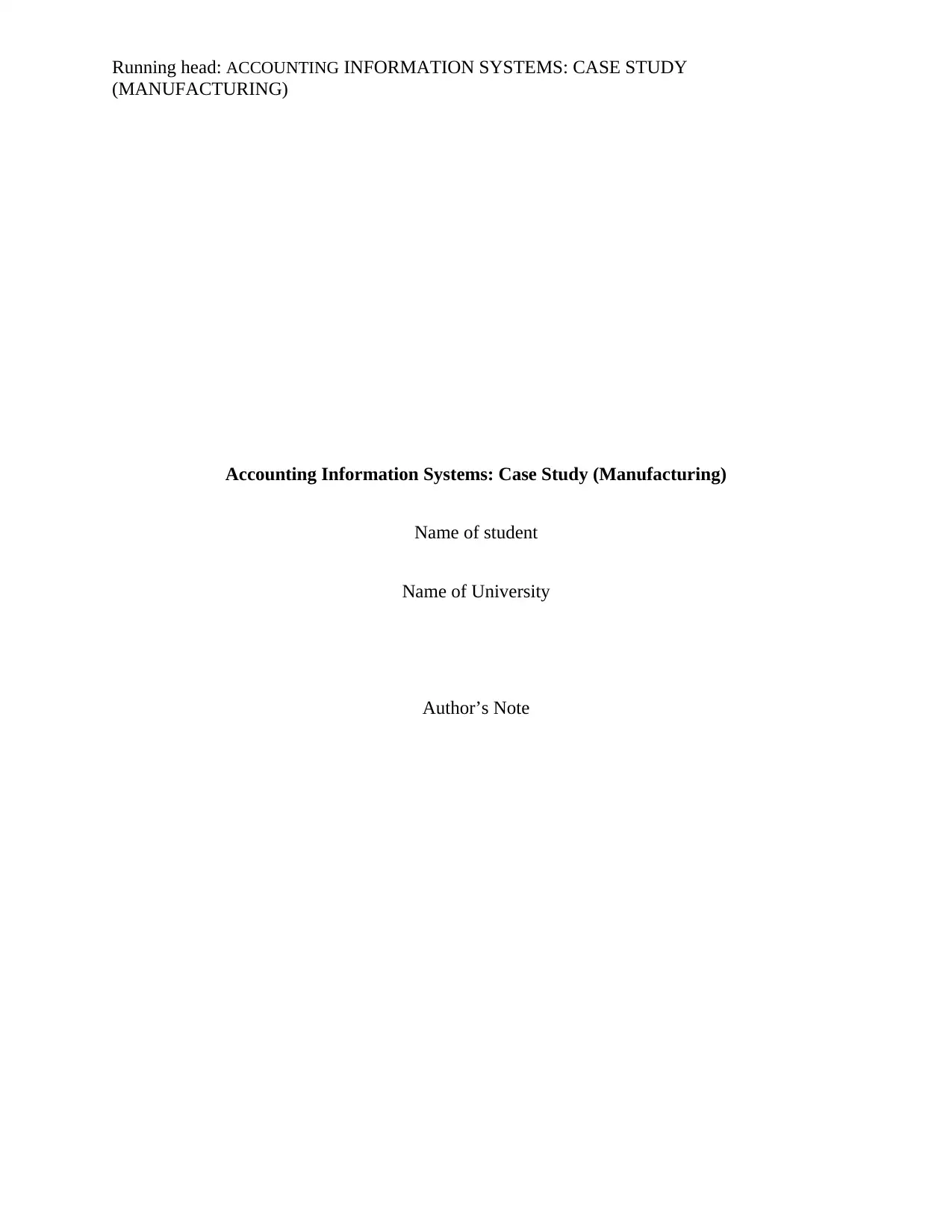
Running head: ACCOUNTING INFORMATION SYSTEMS: CASE STUDY
(MANUFACTURING)
Accounting Information Systems: Case Study (Manufacturing)
Name of student
Name of University
Author’s Note
(MANUFACTURING)
Accounting Information Systems: Case Study (Manufacturing)
Name of student
Name of University
Author’s Note
Paraphrase This Document
Need a fresh take? Get an instant paraphrase of this document with our AI Paraphraser

1ACCOUNTING INFORMATION SYSTEMS: CASE STUDY (MANUFACTURING)
Introduction
Accounting Information System (AIS) is a computer-based method that track the activity
of accounting related with the resources of the information technology. Today Accounting
Information is necessary for the organization to understand the financial situation accurately. It is
important to analyze the long-term strategic decision that has an effect over the manufacturing
industry. Manufacturing and IT alignment is an important concern for the technical and Industry
manager. Information Technology has a positive impact on the productivity and performance of
the Manufacturing Industry. The report will do a case study in the area of Manufacturing and a
research has conducted in Accounting Information System to help the client to take decision for
their investment in the Information System so that they can come up with the next level of their
business. This report discusses the key challenges identified until date. In some cases, the
references have suggested to relate the challenges. The summary of the challenges that have for
each segment has discussed below in the fifth section. The interesting thing that has noticed here
is that most of the industries face the similar challenge. The report will compare the issues and
the challenges faced then contrast them to understand and manage the IS/IT strategically. It will
evaluate the competitive advantage achieve by the organization through IS strategy. By the
innovative use of strategic IS, the organization will be able adopt some approaches. Outsourcing
has used as a strategic option. Here, it has discuss about the strategic option chosen that is the
outsourcing, that would be managed by the Director of IS/IT. The study has include the case
evidence to support the arguments done on the strategic information systems which has add
business value through IS/IT to an organization. Finally the report discusses about the internal
control strategy develop by the organization to avoid the risk that could harm the integrity and
honesty of the organization staff.
Introduction
Accounting Information System (AIS) is a computer-based method that track the activity
of accounting related with the resources of the information technology. Today Accounting
Information is necessary for the organization to understand the financial situation accurately. It is
important to analyze the long-term strategic decision that has an effect over the manufacturing
industry. Manufacturing and IT alignment is an important concern for the technical and Industry
manager. Information Technology has a positive impact on the productivity and performance of
the Manufacturing Industry. The report will do a case study in the area of Manufacturing and a
research has conducted in Accounting Information System to help the client to take decision for
their investment in the Information System so that they can come up with the next level of their
business. This report discusses the key challenges identified until date. In some cases, the
references have suggested to relate the challenges. The summary of the challenges that have for
each segment has discussed below in the fifth section. The interesting thing that has noticed here
is that most of the industries face the similar challenge. The report will compare the issues and
the challenges faced then contrast them to understand and manage the IS/IT strategically. It will
evaluate the competitive advantage achieve by the organization through IS strategy. By the
innovative use of strategic IS, the organization will be able adopt some approaches. Outsourcing
has used as a strategic option. Here, it has discuss about the strategic option chosen that is the
outsourcing, that would be managed by the Director of IS/IT. The study has include the case
evidence to support the arguments done on the strategic information systems which has add
business value through IS/IT to an organization. Finally the report discusses about the internal
control strategy develop by the organization to avoid the risk that could harm the integrity and
honesty of the organization staff.

2ACCOUNTING INFORMATION SYSTEMS: CASE STUDY (MANUFACTURING)
1. Issues face when managing IT/IS strategically in private and public sectors:
Each organization of public and private sectors produce values for stockholders but they
differ in the environment, resources and those of the nature of value for the implications of
creating and implementing strategy of manufacturing. In the sector of public, organization
accountability model of manufacturing has become more complicated. The leadership of the
political is responsible for the strategic information and the leadership of the executive is
responsible for managing the implementation of policies. The strategic management process will
effectively manage the relationship of strategy between the executive and political leadership.
According to Boyne (2015), the issues and the challenges that each sector faces are:
- Service not the 'profit' agenda: an individual require effective and efficient provision
from each of the public and private services to minimize the tax. 'Value' is the guiding concept
for the public sector of the organisation rather than the 'profit' in manufacturing.
- the need for holding up the accountability and transparency of manufacturing in public sector
organization that leads to 'red tape' and bureaucracy and a more risk-averse and less flexible
culture then the private sector.
- Integrating the emerging technologies platform and transferring them.
The above analysis gives the information that in the manufacturing industry public sector
organization are different from private sector organization in which they may have implications
to manage their IT/IS capabilities in manufacturing.
The Manufacturers Alliance for productivity and Innovation (MAPI) and Deloitte
conducted a leading practice of risk assessment. The risk professional has significant challenges
1. Issues face when managing IT/IS strategically in private and public sectors:
Each organization of public and private sectors produce values for stockholders but they
differ in the environment, resources and those of the nature of value for the implications of
creating and implementing strategy of manufacturing. In the sector of public, organization
accountability model of manufacturing has become more complicated. The leadership of the
political is responsible for the strategic information and the leadership of the executive is
responsible for managing the implementation of policies. The strategic management process will
effectively manage the relationship of strategy between the executive and political leadership.
According to Boyne (2015), the issues and the challenges that each sector faces are:
- Service not the 'profit' agenda: an individual require effective and efficient provision
from each of the public and private services to minimize the tax. 'Value' is the guiding concept
for the public sector of the organisation rather than the 'profit' in manufacturing.
- the need for holding up the accountability and transparency of manufacturing in public sector
organization that leads to 'red tape' and bureaucracy and a more risk-averse and less flexible
culture then the private sector.
- Integrating the emerging technologies platform and transferring them.
The above analysis gives the information that in the manufacturing industry public sector
organization are different from private sector organization in which they may have implications
to manage their IT/IS capabilities in manufacturing.
The Manufacturers Alliance for productivity and Innovation (MAPI) and Deloitte
conducted a leading practice of risk assessment. The risk professional has significant challenges
⊘ This is a preview!⊘
Do you want full access?
Subscribe today to unlock all pages.

Trusted by 1+ million students worldwide
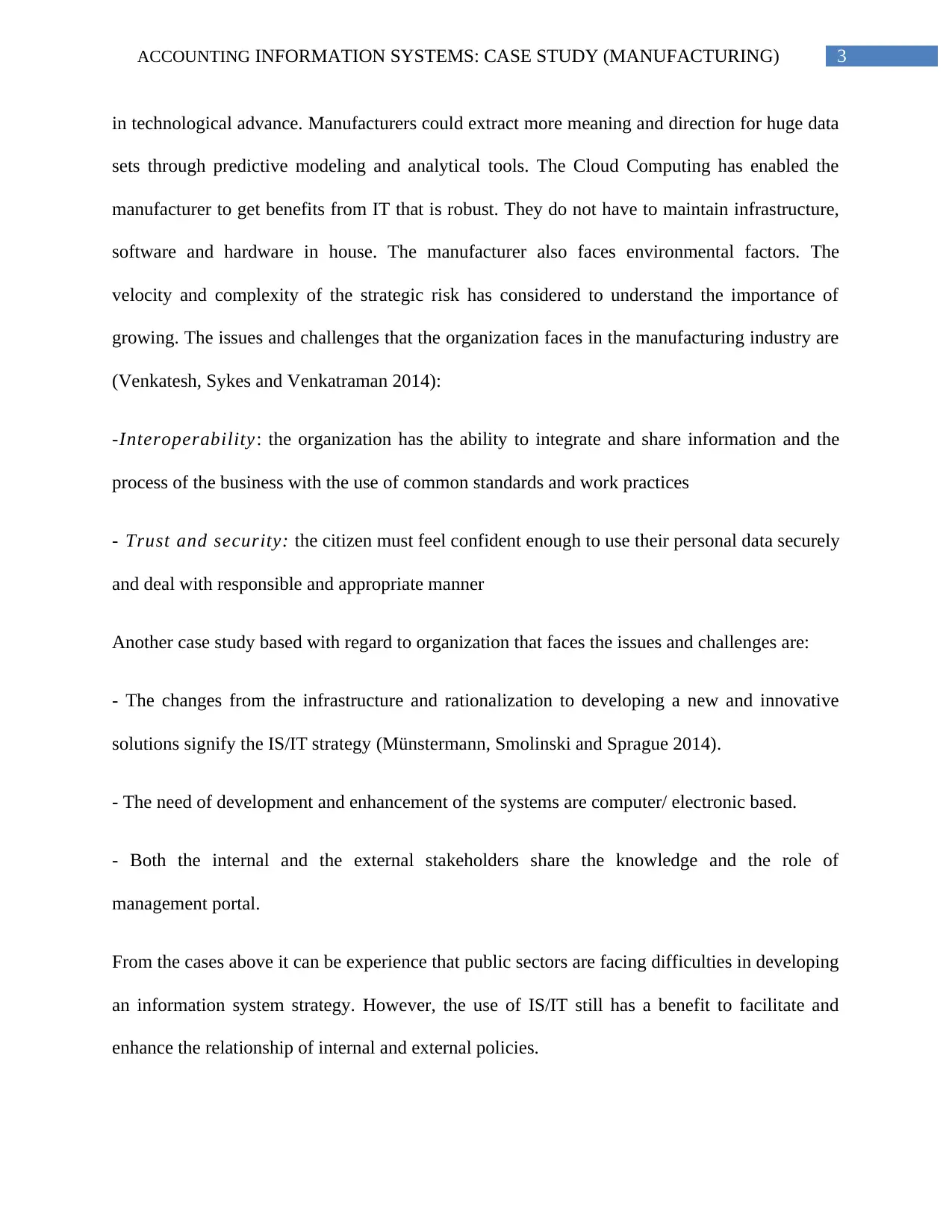
3ACCOUNTING INFORMATION SYSTEMS: CASE STUDY (MANUFACTURING)
in technological advance. Manufacturers could extract more meaning and direction for huge data
sets through predictive modeling and analytical tools. The Cloud Computing has enabled the
manufacturer to get benefits from IT that is robust. They do not have to maintain infrastructure,
software and hardware in house. The manufacturer also faces environmental factors. The
velocity and complexity of the strategic risk has considered to understand the importance of
growing. The issues and challenges that the organization faces in the manufacturing industry are
(Venkatesh, Sykes and Venkatraman 2014):
-Interoperability: the organization has the ability to integrate and share information and the
process of the business with the use of common standards and work practices
- Trust and security: the citizen must feel confident enough to use their personal data securely
and deal with responsible and appropriate manner
Another case study based with regard to organization that faces the issues and challenges are:
- The changes from the infrastructure and rationalization to developing a new and innovative
solutions signify the IS/IT strategy (Münstermann, Smolinski and Sprague 2014).
- The need of development and enhancement of the systems are computer/ electronic based.
- Both the internal and the external stakeholders share the knowledge and the role of
management portal.
From the cases above it can be experience that public sectors are facing difficulties in developing
an information system strategy. However, the use of IS/IT still has a benefit to facilitate and
enhance the relationship of internal and external policies.
in technological advance. Manufacturers could extract more meaning and direction for huge data
sets through predictive modeling and analytical tools. The Cloud Computing has enabled the
manufacturer to get benefits from IT that is robust. They do not have to maintain infrastructure,
software and hardware in house. The manufacturer also faces environmental factors. The
velocity and complexity of the strategic risk has considered to understand the importance of
growing. The issues and challenges that the organization faces in the manufacturing industry are
(Venkatesh, Sykes and Venkatraman 2014):
-Interoperability: the organization has the ability to integrate and share information and the
process of the business with the use of common standards and work practices
- Trust and security: the citizen must feel confident enough to use their personal data securely
and deal with responsible and appropriate manner
Another case study based with regard to organization that faces the issues and challenges are:
- The changes from the infrastructure and rationalization to developing a new and innovative
solutions signify the IS/IT strategy (Münstermann, Smolinski and Sprague 2014).
- The need of development and enhancement of the systems are computer/ electronic based.
- Both the internal and the external stakeholders share the knowledge and the role of
management portal.
From the cases above it can be experience that public sectors are facing difficulties in developing
an information system strategy. However, the use of IS/IT still has a benefit to facilitate and
enhance the relationship of internal and external policies.
Paraphrase This Document
Need a fresh take? Get an instant paraphrase of this document with our AI Paraphraser
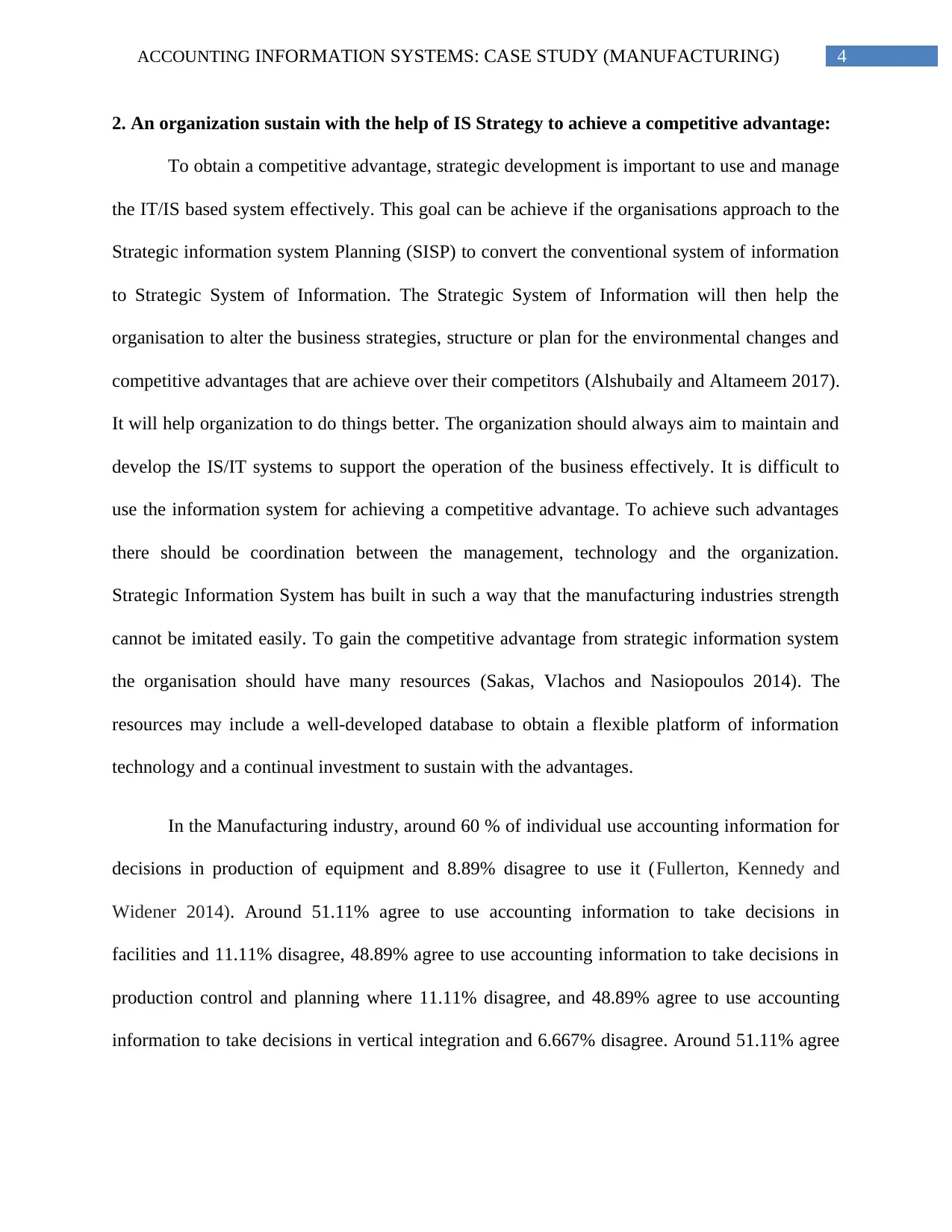
4ACCOUNTING INFORMATION SYSTEMS: CASE STUDY (MANUFACTURING)
2. An organization sustain with the help of IS Strategy to achieve a competitive advantage:
To obtain a competitive advantage, strategic development is important to use and manage
the IT/IS based system effectively. This goal can be achieve if the organisations approach to the
Strategic information system Planning (SISP) to convert the conventional system of information
to Strategic System of Information. The Strategic System of Information will then help the
organisation to alter the business strategies, structure or plan for the environmental changes and
competitive advantages that are achieve over their competitors (Alshubaily and Altameem 2017).
It will help organization to do things better. The organization should always aim to maintain and
develop the IS/IT systems to support the operation of the business effectively. It is difficult to
use the information system for achieving a competitive advantage. To achieve such advantages
there should be coordination between the management, technology and the organization.
Strategic Information System has built in such a way that the manufacturing industries strength
cannot be imitated easily. To gain the competitive advantage from strategic information system
the organisation should have many resources (Sakas, Vlachos and Nasiopoulos 2014). The
resources may include a well-developed database to obtain a flexible platform of information
technology and a continual investment to sustain with the advantages.
In the Manufacturing industry, around 60 % of individual use accounting information for
decisions in production of equipment and 8.89% disagree to use it (Fullerton, Kennedy and
Widener 2014). Around 51.11% agree to use accounting information to take decisions in
facilities and 11.11% disagree, 48.89% agree to use accounting information to take decisions in
production control and planning where 11.11% disagree, and 48.89% agree to use accounting
information to take decisions in vertical integration and 6.667% disagree. Around 51.11% agree
2. An organization sustain with the help of IS Strategy to achieve a competitive advantage:
To obtain a competitive advantage, strategic development is important to use and manage
the IT/IS based system effectively. This goal can be achieve if the organisations approach to the
Strategic information system Planning (SISP) to convert the conventional system of information
to Strategic System of Information. The Strategic System of Information will then help the
organisation to alter the business strategies, structure or plan for the environmental changes and
competitive advantages that are achieve over their competitors (Alshubaily and Altameem 2017).
It will help organization to do things better. The organization should always aim to maintain and
develop the IS/IT systems to support the operation of the business effectively. It is difficult to
use the information system for achieving a competitive advantage. To achieve such advantages
there should be coordination between the management, technology and the organization.
Strategic Information System has built in such a way that the manufacturing industries strength
cannot be imitated easily. To gain the competitive advantage from strategic information system
the organisation should have many resources (Sakas, Vlachos and Nasiopoulos 2014). The
resources may include a well-developed database to obtain a flexible platform of information
technology and a continual investment to sustain with the advantages.
In the Manufacturing industry, around 60 % of individual use accounting information for
decisions in production of equipment and 8.89% disagree to use it (Fullerton, Kennedy and
Widener 2014). Around 51.11% agree to use accounting information to take decisions in
facilities and 11.11% disagree, 48.89% agree to use accounting information to take decisions in
production control and planning where 11.11% disagree, and 48.89% agree to use accounting
information to take decisions in vertical integration and 6.667% disagree. Around 51.11% agree

5ACCOUNTING INFORMATION SYSTEMS: CASE STUDY (MANUFACTURING)
to use accounting information to take decisions in production quality trade and cost controlling
and 6.667% disagree.
It is recommended to follow some proposed conditions before the development and
implementation of strategic information system that includes:
- The senior organization management active support, to discover the implementation
process and the strategic opportunities
- To integrate a plan for use of strategic information system into the process of overall
organization of strategic planning
- To report directly to the business managers those that affect the use of strategic
information system
- To place the control mechanisms in the hand of business managers
- To be always ready to use the strategy for information system
3. Approaches made by an organization to develop innovative uses of strategic IS:
In the Strategic Information System, the manufacturing organization uses the information
system to develop an effective innovation for the use of strategic IS. It is essential for the success
of the organization in the present business environment globally. The organization can adopt the
use of information system to create and identify the new products and the services for the
development of the niche market (Veselovsky et al. 2015). The internet and telecommunication
network gives better opportunities to develop innovative use of strategic IS in manufacturing. It
is also essential to align the information system and the IS/IT application with the business
to use accounting information to take decisions in production quality trade and cost controlling
and 6.667% disagree.
It is recommended to follow some proposed conditions before the development and
implementation of strategic information system that includes:
- The senior organization management active support, to discover the implementation
process and the strategic opportunities
- To integrate a plan for use of strategic information system into the process of overall
organization of strategic planning
- To report directly to the business managers those that affect the use of strategic
information system
- To place the control mechanisms in the hand of business managers
- To be always ready to use the strategy for information system
3. Approaches made by an organization to develop innovative uses of strategic IS:
In the Strategic Information System, the manufacturing organization uses the information
system to develop an effective innovation for the use of strategic IS. It is essential for the success
of the organization in the present business environment globally. The organization can adopt the
use of information system to create and identify the new products and the services for the
development of the niche market (Veselovsky et al. 2015). The internet and telecommunication
network gives better opportunities to develop innovative use of strategic IS in manufacturing. It
is also essential to align the information system and the IS/IT application with the business
⊘ This is a preview!⊘
Do you want full access?
Subscribe today to unlock all pages.

Trusted by 1+ million students worldwide
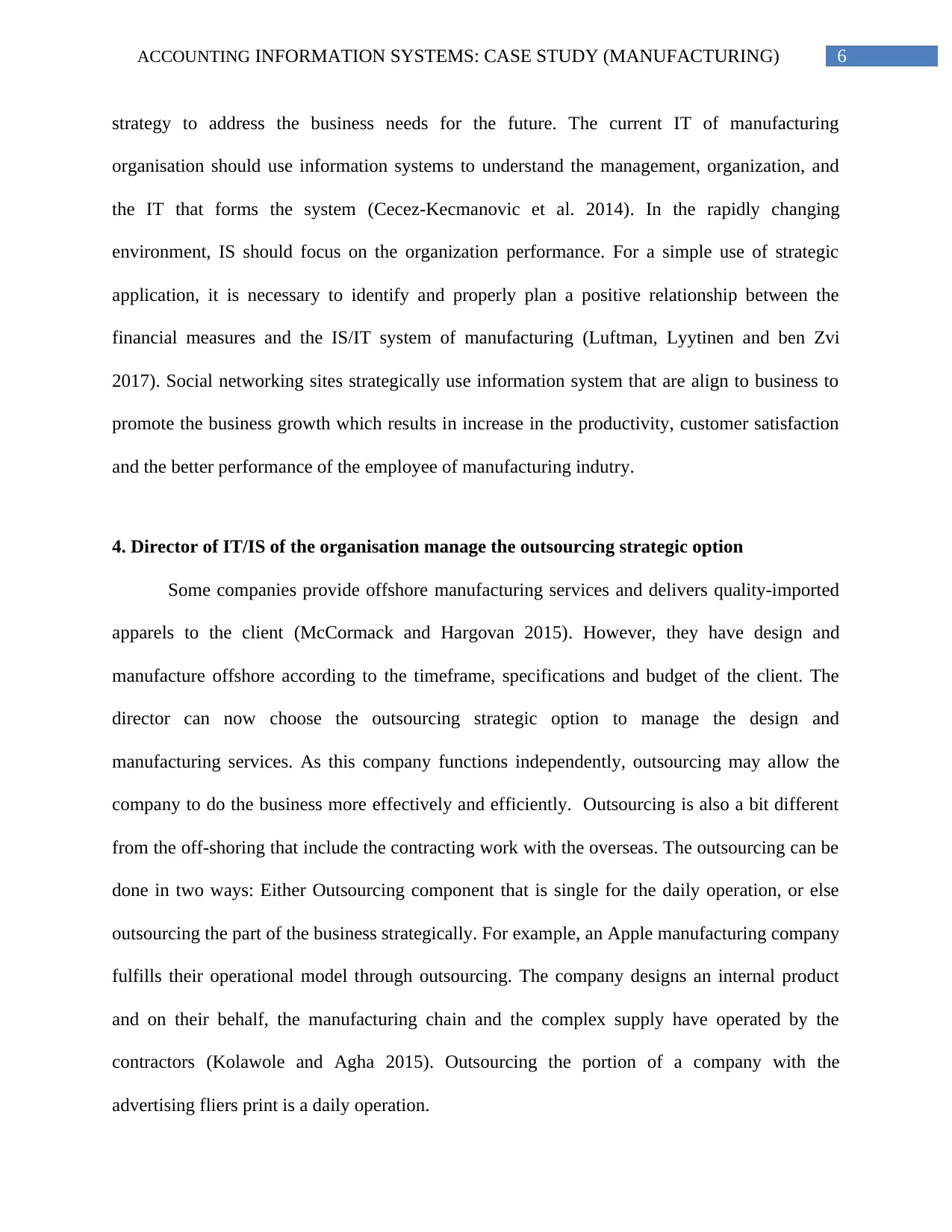
6ACCOUNTING INFORMATION SYSTEMS: CASE STUDY (MANUFACTURING)
strategy to address the business needs for the future. The current IT of manufacturing
organisation should use information systems to understand the management, organization, and
the IT that forms the system (Cecez-Kecmanovic et al. 2014). In the rapidly changing
environment, IS should focus on the organization performance. For a simple use of strategic
application, it is necessary to identify and properly plan a positive relationship between the
financial measures and the IS/IT system of manufacturing (Luftman, Lyytinen and ben Zvi
2017). Social networking sites strategically use information system that are align to business to
promote the business growth which results in increase in the productivity, customer satisfaction
and the better performance of the employee of manufacturing indutry.
4. Director of IT/IS of the organisation manage the outsourcing strategic option
Some companies provide offshore manufacturing services and delivers quality-imported
apparels to the client (McCormack and Hargovan 2015). However, they have design and
manufacture offshore according to the timeframe, specifications and budget of the client. The
director can now choose the outsourcing strategic option to manage the design and
manufacturing services. As this company functions independently, outsourcing may allow the
company to do the business more effectively and efficiently. Outsourcing is also a bit different
from the off-shoring that include the contracting work with the overseas. The outsourcing can be
done in two ways: Either Outsourcing component that is single for the daily operation, or else
outsourcing the part of the business strategically. For example, an Apple manufacturing company
fulfills their operational model through outsourcing. The company designs an internal product
and on their behalf, the manufacturing chain and the complex supply have operated by the
contractors (Kolawole and Agha 2015). Outsourcing the portion of a company with the
advertising fliers print is a daily operation.
strategy to address the business needs for the future. The current IT of manufacturing
organisation should use information systems to understand the management, organization, and
the IT that forms the system (Cecez-Kecmanovic et al. 2014). In the rapidly changing
environment, IS should focus on the organization performance. For a simple use of strategic
application, it is necessary to identify and properly plan a positive relationship between the
financial measures and the IS/IT system of manufacturing (Luftman, Lyytinen and ben Zvi
2017). Social networking sites strategically use information system that are align to business to
promote the business growth which results in increase in the productivity, customer satisfaction
and the better performance of the employee of manufacturing indutry.
4. Director of IT/IS of the organisation manage the outsourcing strategic option
Some companies provide offshore manufacturing services and delivers quality-imported
apparels to the client (McCormack and Hargovan 2015). However, they have design and
manufacture offshore according to the timeframe, specifications and budget of the client. The
director can now choose the outsourcing strategic option to manage the design and
manufacturing services. As this company functions independently, outsourcing may allow the
company to do the business more effectively and efficiently. Outsourcing is also a bit different
from the off-shoring that include the contracting work with the overseas. The outsourcing can be
done in two ways: Either Outsourcing component that is single for the daily operation, or else
outsourcing the part of the business strategically. For example, an Apple manufacturing company
fulfills their operational model through outsourcing. The company designs an internal product
and on their behalf, the manufacturing chain and the complex supply have operated by the
contractors (Kolawole and Agha 2015). Outsourcing the portion of a company with the
advertising fliers print is a daily operation.
Paraphrase This Document
Need a fresh take? Get an instant paraphrase of this document with our AI Paraphraser
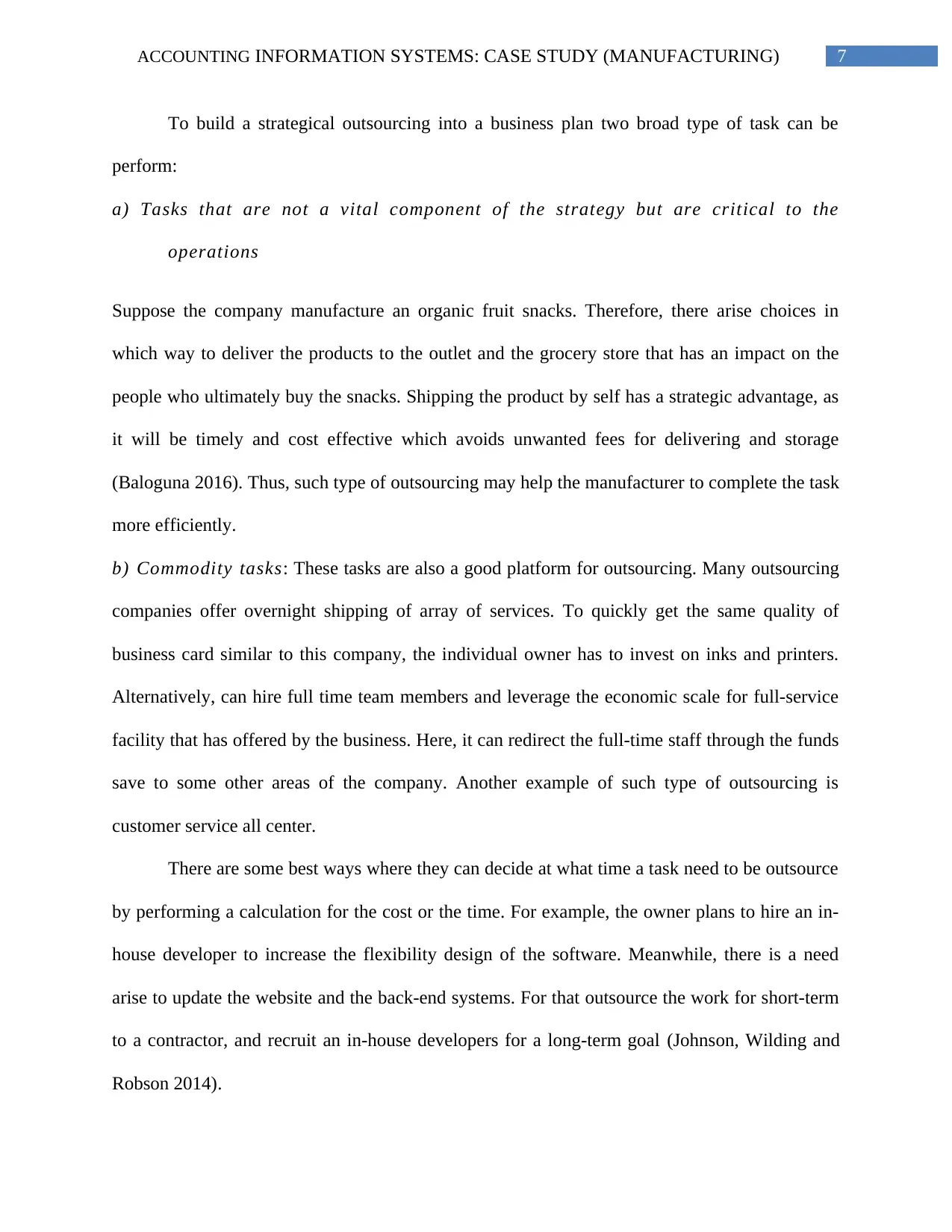
7ACCOUNTING INFORMATION SYSTEMS: CASE STUDY (MANUFACTURING)
To build a strategical outsourcing into a business plan two broad type of task can be
perform:
a) Tasks that are not a vital component of the strategy but are critical to the
operations
Suppose the company manufacture an organic fruit snacks. Therefore, there arise choices in
which way to deliver the products to the outlet and the grocery store that has an impact on the
people who ultimately buy the snacks. Shipping the product by self has a strategic advantage, as
it will be timely and cost effective which avoids unwanted fees for delivering and storage
(Baloguna 2016). Thus, such type of outsourcing may help the manufacturer to complete the task
more efficiently.
b) Commodity tasks: These tasks are also a good platform for outsourcing. Many outsourcing
companies offer overnight shipping of array of services. To quickly get the same quality of
business card similar to this company, the individual owner has to invest on inks and printers.
Alternatively, can hire full time team members and leverage the economic scale for full-service
facility that has offered by the business. Here, it can redirect the full-time staff through the funds
save to some other areas of the company. Another example of such type of outsourcing is
customer service all center.
There are some best ways where they can decide at what time a task need to be outsource
by performing a calculation for the cost or the time. For example, the owner plans to hire an in-
house developer to increase the flexibility design of the software. Meanwhile, there is a need
arise to update the website and the back-end systems. For that outsource the work for short-term
to a contractor, and recruit an in-house developers for a long-term goal (Johnson, Wilding and
Robson 2014).
To build a strategical outsourcing into a business plan two broad type of task can be
perform:
a) Tasks that are not a vital component of the strategy but are critical to the
operations
Suppose the company manufacture an organic fruit snacks. Therefore, there arise choices in
which way to deliver the products to the outlet and the grocery store that has an impact on the
people who ultimately buy the snacks. Shipping the product by self has a strategic advantage, as
it will be timely and cost effective which avoids unwanted fees for delivering and storage
(Baloguna 2016). Thus, such type of outsourcing may help the manufacturer to complete the task
more efficiently.
b) Commodity tasks: These tasks are also a good platform for outsourcing. Many outsourcing
companies offer overnight shipping of array of services. To quickly get the same quality of
business card similar to this company, the individual owner has to invest on inks and printers.
Alternatively, can hire full time team members and leverage the economic scale for full-service
facility that has offered by the business. Here, it can redirect the full-time staff through the funds
save to some other areas of the company. Another example of such type of outsourcing is
customer service all center.
There are some best ways where they can decide at what time a task need to be outsource
by performing a calculation for the cost or the time. For example, the owner plans to hire an in-
house developer to increase the flexibility design of the software. Meanwhile, there is a need
arise to update the website and the back-end systems. For that outsource the work for short-term
to a contractor, and recruit an in-house developers for a long-term goal (Johnson, Wilding and
Robson 2014).
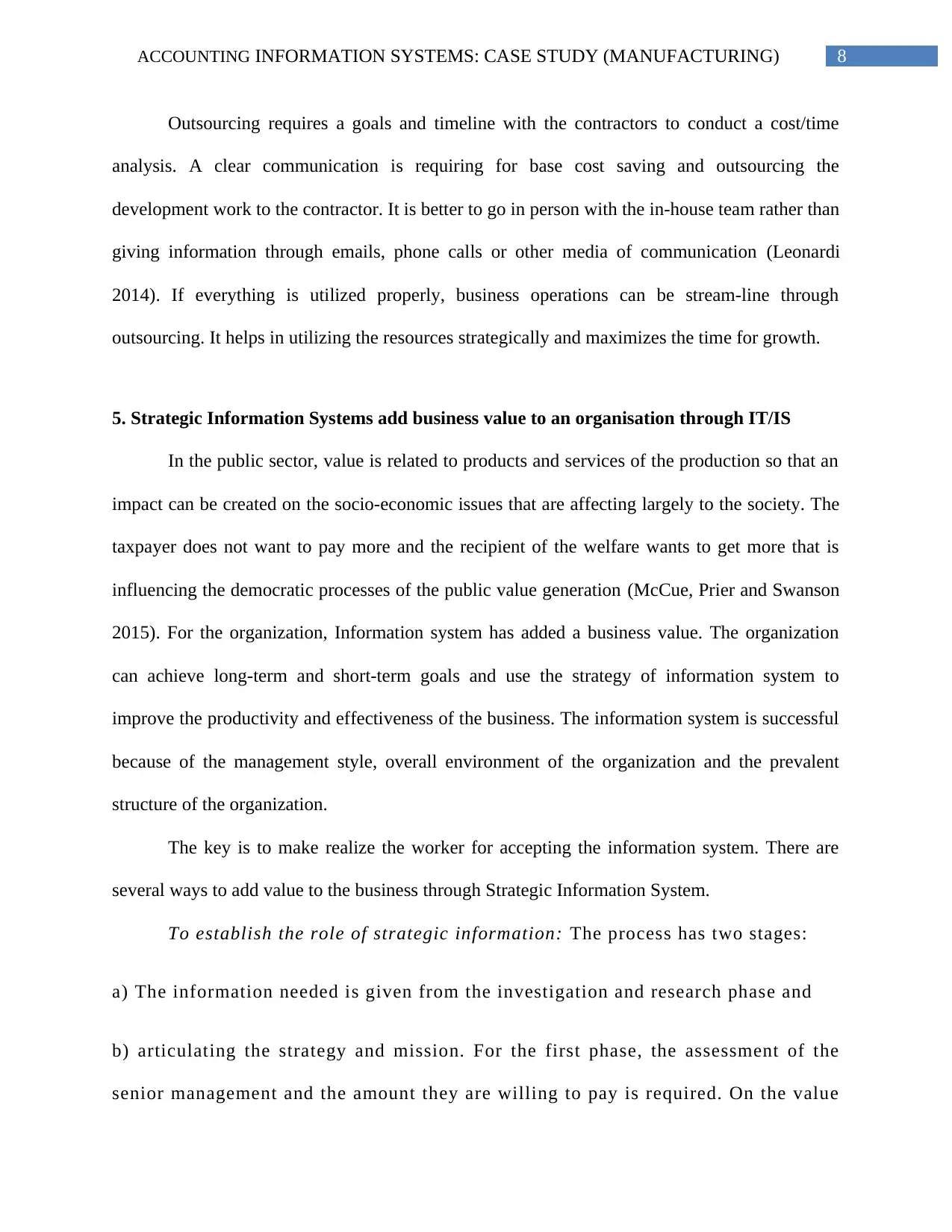
8ACCOUNTING INFORMATION SYSTEMS: CASE STUDY (MANUFACTURING)
Outsourcing requires a goals and timeline with the contractors to conduct a cost/time
analysis. A clear communication is requiring for base cost saving and outsourcing the
development work to the contractor. It is better to go in person with the in-house team rather than
giving information through emails, phone calls or other media of communication (Leonardi
2014). If everything is utilized properly, business operations can be stream-line through
outsourcing. It helps in utilizing the resources strategically and maximizes the time for growth.
5. Strategic Information Systems add business value to an organisation through IT/IS
In the public sector, value is related to products and services of the production so that an
impact can be created on the socio-economic issues that are affecting largely to the society. The
taxpayer does not want to pay more and the recipient of the welfare wants to get more that is
influencing the democratic processes of the public value generation (McCue, Prier and Swanson
2015). For the organization, Information system has added a business value. The organization
can achieve long-term and short-term goals and use the strategy of information system to
improve the productivity and effectiveness of the business. The information system is successful
because of the management style, overall environment of the organization and the prevalent
structure of the organization.
The key is to make realize the worker for accepting the information system. There are
several ways to add value to the business through Strategic Information System.
To establish the role of strategic information: The process has two stages:
a) The information needed is given from the investigation and research phase and
b) articulating the strategy and mission. For the first phase, the assessment of the
senior management and the amount they are willing to pay is required. On the value
Outsourcing requires a goals and timeline with the contractors to conduct a cost/time
analysis. A clear communication is requiring for base cost saving and outsourcing the
development work to the contractor. It is better to go in person with the in-house team rather than
giving information through emails, phone calls or other media of communication (Leonardi
2014). If everything is utilized properly, business operations can be stream-line through
outsourcing. It helps in utilizing the resources strategically and maximizes the time for growth.
5. Strategic Information Systems add business value to an organisation through IT/IS
In the public sector, value is related to products and services of the production so that an
impact can be created on the socio-economic issues that are affecting largely to the society. The
taxpayer does not want to pay more and the recipient of the welfare wants to get more that is
influencing the democratic processes of the public value generation (McCue, Prier and Swanson
2015). For the organization, Information system has added a business value. The organization
can achieve long-term and short-term goals and use the strategy of information system to
improve the productivity and effectiveness of the business. The information system is successful
because of the management style, overall environment of the organization and the prevalent
structure of the organization.
The key is to make realize the worker for accepting the information system. There are
several ways to add value to the business through Strategic Information System.
To establish the role of strategic information: The process has two stages:
a) The information needed is given from the investigation and research phase and
b) articulating the strategy and mission. For the first phase, the assessment of the
senior management and the amount they are willing to pay is required. On the value
⊘ This is a preview!⊘
Do you want full access?
Subscribe today to unlock all pages.

Trusted by 1+ million students worldwide

9ACCOUNTING INFORMATION SYSTEMS: CASE STUDY (MANUFACTURING)
of competitor intelligence a direct link has been delivered between the bottom line
and the large strategic investment. A good information is available for the
successful outcome of the strategic decisions that include new investment, new
launch and product development, promotion and pricing, location of the offices and
factories, and selection of the market and targeting (Zedtwitz et al. 2015). From all
this investigation, a role can be played to determine the area of high information
leverage.
To identify what the users really need: For any strategic information, it is
essential to research about the market. Therefore, the methods like interview, usage
analysis or survey that are used by the researcher can be used. It will help to
achieve the results and benefits.
To segment the market: Grouping the common needs of the customer into a
segment is a keystone for the marketing strategy. The common pitfalls conflicts
between the ‘important and the urgent’ can be overcome by defining the method of
segments to develop different pricing, resources and services approach (Kindström
and Kowalkowski 2014).
To create a product uniquely: There are some aspects in which values can be
added to information and the challenges made to customize it. Some of the aspects
are timeliness, accessibility, usability, utility, quality, medium, repacking,
flexibility, customized and reusability.
Marketing and sale: For a unit to have a successful information to sell and
market its services is an important aspects of marketing. In this event, it is
of competitor intelligence a direct link has been delivered between the bottom line
and the large strategic investment. A good information is available for the
successful outcome of the strategic decisions that include new investment, new
launch and product development, promotion and pricing, location of the offices and
factories, and selection of the market and targeting (Zedtwitz et al. 2015). From all
this investigation, a role can be played to determine the area of high information
leverage.
To identify what the users really need: For any strategic information, it is
essential to research about the market. Therefore, the methods like interview, usage
analysis or survey that are used by the researcher can be used. It will help to
achieve the results and benefits.
To segment the market: Grouping the common needs of the customer into a
segment is a keystone for the marketing strategy. The common pitfalls conflicts
between the ‘important and the urgent’ can be overcome by defining the method of
segments to develop different pricing, resources and services approach (Kindström
and Kowalkowski 2014).
To create a product uniquely: There are some aspects in which values can be
added to information and the challenges made to customize it. Some of the aspects
are timeliness, accessibility, usability, utility, quality, medium, repacking,
flexibility, customized and reusability.
Marketing and sale: For a unit to have a successful information to sell and
market its services is an important aspects of marketing. In this event, it is
Paraphrase This Document
Need a fresh take? Get an instant paraphrase of this document with our AI Paraphraser

10ACCOUNTING INFORMATION SYSTEMS: CASE STUDY (MANUFACTURING)
necessary to meet the customer through in-house conference for annual research or
sales meeting. Another aspect of marketing is pricing that add value to business.
Evaluating and receiving feedback: Receiving feedback and evaluation give a
tune to the product offer and the strategy of the market.
Exploiting the technology: The information technology will be used to
leverage the scarce resources and offers opportunities that give a great benefit of
technology that allows access to virtual library for the collection of the information
from the desktop of the user’s.
Making a selective outsourcing: Outsourcing is the fashion of current
management to attract the broader range of skills and knowledge with low cost.
Through outsourcing, some specialist retains information skills to manage and
select the external contractors (Hajduk 2016).
Building a better partnership: The level of partnership with the clients and
suppliers can be strengthened through organization level, individual and teams.
Developing hybrid skills: As a information professional, business can be
improved by broadening the skills to become a hybrid. Therefore, to remain as a
specialist, it is better to take time and develop the skills through management
training and joining courses and event of the industry (Ashari et al. 2014).
6. Develop a good Internal Control Strategy
An internal control is a procedure adopt in a business to ensure a reliable and accurate
financial information compliance with the operational requirement to achieve the objectives of
necessary to meet the customer through in-house conference for annual research or
sales meeting. Another aspect of marketing is pricing that add value to business.
Evaluating and receiving feedback: Receiving feedback and evaluation give a
tune to the product offer and the strategy of the market.
Exploiting the technology: The information technology will be used to
leverage the scarce resources and offers opportunities that give a great benefit of
technology that allows access to virtual library for the collection of the information
from the desktop of the user’s.
Making a selective outsourcing: Outsourcing is the fashion of current
management to attract the broader range of skills and knowledge with low cost.
Through outsourcing, some specialist retains information skills to manage and
select the external contractors (Hajduk 2016).
Building a better partnership: The level of partnership with the clients and
suppliers can be strengthened through organization level, individual and teams.
Developing hybrid skills: As a information professional, business can be
improved by broadening the skills to become a hybrid. Therefore, to remain as a
specialist, it is better to take time and develop the skills through management
training and joining courses and event of the industry (Ashari et al. 2014).
6. Develop a good Internal Control Strategy
An internal control is a procedure adopt in a business to ensure a reliable and accurate
financial information compliance with the operational requirement to achieve the objectives of
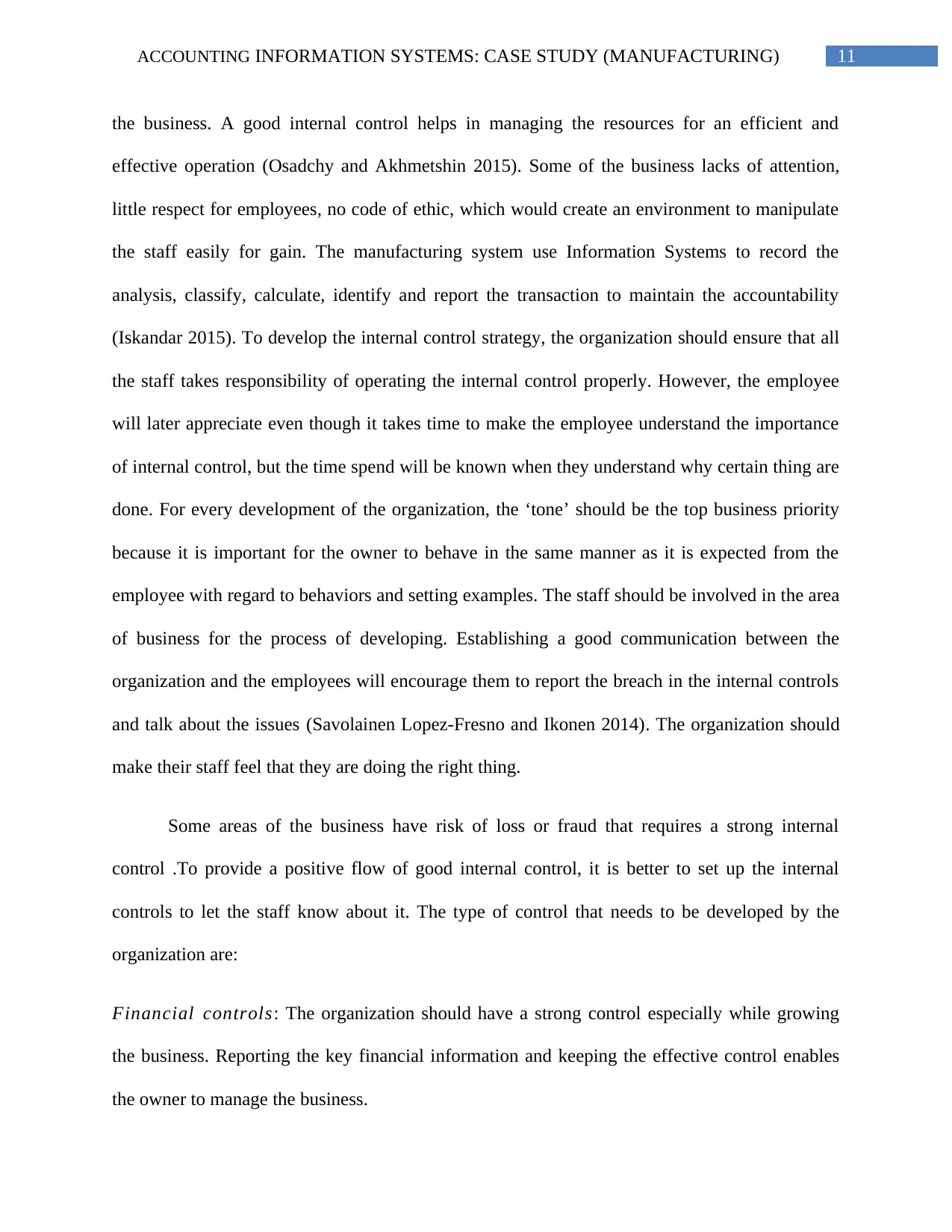
11ACCOUNTING INFORMATION SYSTEMS: CASE STUDY (MANUFACTURING)
the business. A good internal control helps in managing the resources for an efficient and
effective operation (Osadchy and Akhmetshin 2015). Some of the business lacks of attention,
little respect for employees, no code of ethic, which would create an environment to manipulate
the staff easily for gain. The manufacturing system use Information Systems to record the
analysis, classify, calculate, identify and report the transaction to maintain the accountability
(Iskandar 2015). To develop the internal control strategy, the organization should ensure that all
the staff takes responsibility of operating the internal control properly. However, the employee
will later appreciate even though it takes time to make the employee understand the importance
of internal control, but the time spend will be known when they understand why certain thing are
done. For every development of the organization, the ‘tone’ should be the top business priority
because it is important for the owner to behave in the same manner as it is expected from the
employee with regard to behaviors and setting examples. The staff should be involved in the area
of business for the process of developing. Establishing a good communication between the
organization and the employees will encourage them to report the breach in the internal controls
and talk about the issues (Savolainen Lopez-Fresno and Ikonen 2014). The organization should
make their staff feel that they are doing the right thing.
Some areas of the business have risk of loss or fraud that requires a strong internal
control .To provide a positive flow of good internal control, it is better to set up the internal
controls to let the staff know about it. The type of control that needs to be developed by the
organization are:
Financial controls: The organization should have a strong control especially while growing
the business. Reporting the key financial information and keeping the effective control enables
the owner to manage the business.
the business. A good internal control helps in managing the resources for an efficient and
effective operation (Osadchy and Akhmetshin 2015). Some of the business lacks of attention,
little respect for employees, no code of ethic, which would create an environment to manipulate
the staff easily for gain. The manufacturing system use Information Systems to record the
analysis, classify, calculate, identify and report the transaction to maintain the accountability
(Iskandar 2015). To develop the internal control strategy, the organization should ensure that all
the staff takes responsibility of operating the internal control properly. However, the employee
will later appreciate even though it takes time to make the employee understand the importance
of internal control, but the time spend will be known when they understand why certain thing are
done. For every development of the organization, the ‘tone’ should be the top business priority
because it is important for the owner to behave in the same manner as it is expected from the
employee with regard to behaviors and setting examples. The staff should be involved in the area
of business for the process of developing. Establishing a good communication between the
organization and the employees will encourage them to report the breach in the internal controls
and talk about the issues (Savolainen Lopez-Fresno and Ikonen 2014). The organization should
make their staff feel that they are doing the right thing.
Some areas of the business have risk of loss or fraud that requires a strong internal
control .To provide a positive flow of good internal control, it is better to set up the internal
controls to let the staff know about it. The type of control that needs to be developed by the
organization are:
Financial controls: The organization should have a strong control especially while growing
the business. Reporting the key financial information and keeping the effective control enables
the owner to manage the business.
⊘ This is a preview!⊘
Do you want full access?
Subscribe today to unlock all pages.

Trusted by 1+ million students worldwide
1 out of 18